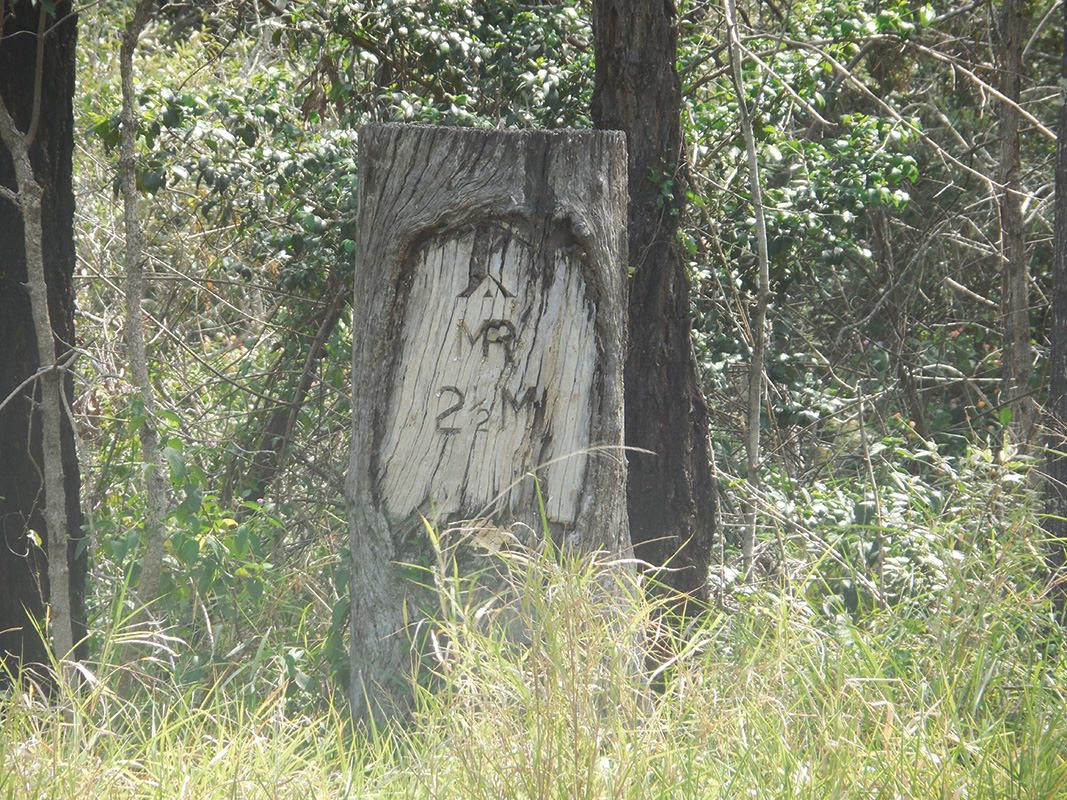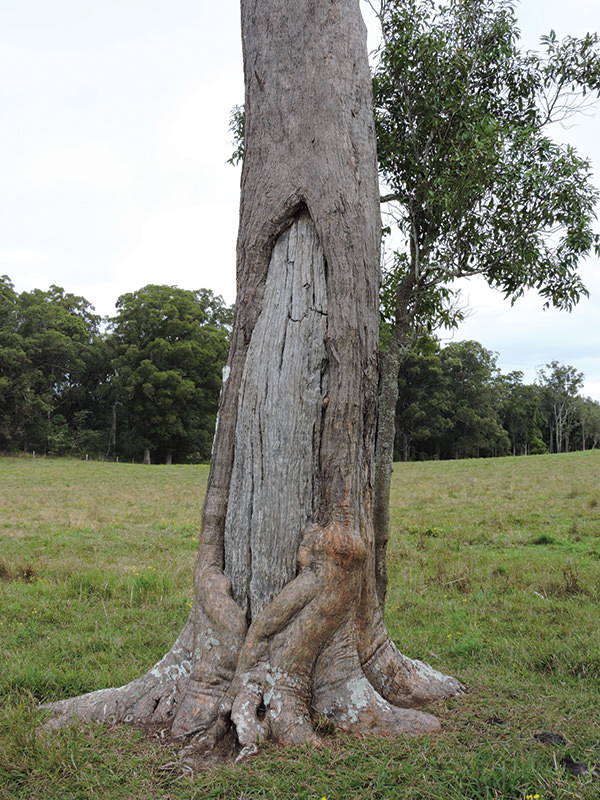Most properties in Land for Wildlife have a patch of bushland, swamp or forest as the main feature. Other owners are either enhancing their bushland through weeding and natural regeneration or through planting because they love native plants generally.
However, many owners may not be aware that they may have ‘veteran’ trees growing on their property.
So what are veteran trees? They are very old trees that may be hundreds of years old. In a few instances, they may be closer to 1,000 years old. These trees may be old and gnarly or if growing on very poor soils, they may not have very thick trunks. If areas have been logged, then these types of trees would have been the first to be harvested. Thus, you may have slightly younger trees growing around your property. They are still valuable for the environment.
Values of Veteran Trees
Trees of all ages and sizes provide many benefits to a property, wildlife, the broader environment and they give us lots of pleasure. Veteran trees may contain DNA of the forests that grew in Australia tens of thousands of years ago.
Like all trees, veteran trees stabilise the soil under their driplines. They provide shade, shelter, perches and breeding sites for many invertebrates, birds, mammals and reptiles.
All trees, and especially veteran trees, are very efficient water pumps. They pump water from deep in the soil to the leaves at the extreme top of the branches. In addition, they exert pressure to keep water deep in the soil to prevent salination of the ground surface. Veteran trees can even create their own ecosystems and micro-climates, and some insects and fungi are restricted to the unique soil or conditions around one tree species.
One of their key offerings is tree hollows. Hollows are essential for many native animals that play a beneficial role in keeping the landscape healthy. Hollows tend to develop after about 100 years in many eucalypts, but researchers believe that the hollows most valued by wildlife take about 200 years. About 95 species of native mammals (i.e. possums, gliders, insectivorous bats) and about 50 native bird species use hollows.
Hollow-bearing trees, such as isolated paddock trees, in semi-agricultural landscapes provide habitats for beneficial invertebrates such as native bees which are critical for the pollination of our vegetable and grain crops. These trees also provide habitat for spiders and raptors, which eat agricultural pests like grasshoppers and introduced mice.
Historic Values
Veteran trees may also contain marks and scars made by humans.
Veteran trees containing marks and carvings made historically or recently by Indigenous people occur throughout south-east Queensland. Traditionally, Indigenous people removed bark from old trees to make shelters, containers, shields and canoes. They made toeholds in trees to help climb them to collect food such as ‘sugarbag’ or native honey. Certain species of trees were used for certain purposes depending on the qualities of the bark.
The scars and carvings on trees can tell us about the tools (i.e. stone or metal axes) that were used to make them. Indigenous people strongly identify with the significant cultural trees left in today’s landscape and locations of sites that once contained culturally important trees. Veteran trees were, and still are, markers in the landscape to sacred sites, waterholes and Indigenous language group boundaries. The scars on Indigenous cultural trees today provide insights into Australia’s recent history and are important for all Australians.
European explorers also marked trees while traversing the continent. Few of those scarred trees remain, but where they do, they can reveal the explorers’ travels and sometimes fate. Early European settlers likewise marked trees to identify paddock boundaries. They also removed bark for roofing shingles, leaving clearly identifiable marks and scars.
As trees age they grow outwards, not continually upwards, just like us in middle age. The major stem (trunk) and some of the side branches may need judicious pruning to keep the tree healthy.

Protecting the Root Zone
The root zone of some veteran trees need management to provide the best circumstances for continued growth. Many isolated veteran paddock trees are highly sought after by stock for shade and shelter. Some trees are used as storage sites for chemicals, fencing and property management materials. Chemical leakage or soil compaction by stock or vehicles may damage the root zone and lead to the tree becoming unhealthy or dying.
If the veteran tree is in a park or garden, natural mulch from nearby bushland areas may be used to regulate soil temperature and moisture levels.
If the veteran tree is in a natural bushland area, it will self-manage, and no human intervention is required.
Controlling weeds growing at the base of veteran trees is sometimes required. However, any weed removal should be done slowly to reduce soil impacts, sunscald or dehydration due to a dramatic increase in sunlight when the weeds are removed. Low impact weeding methods such as cut-and-paste, frilling, wicking or hand-pulling are preferred, and any sprays should be avoided as they can directly damage the tree’s roots and soil ecosystems.
Weed mats, geotextiles and similar erosion-control fabrics should be avoided as they can hinder nutrient recycling.
Protection of Highly Visited Trees
Some of our ancient trees in public reserves are highly visited and risk having the soil compacted and diseases such as phytophthora introduced. In such circumstances it is best to place a seat around the edge of the tree’s drip line to allow people to enjoy the tree without stressing it.
Protection from Fences
Fence damage is usually seen with wires ‘eating’ into the bark of a veteran tree with the tree gradually be ring-barked. Locating fence lines and vehicle tracks beyond the drip-line enhances the ability of the tree to survive in a healthy state.
Regeneration
Veteran trees have several survival strategies such as: crown retrenchment whereby the tree limits water to the canopy; epicormic bud growth after drought or fire; and, coppicing from lignotubers (large underground root structures). Coppicing allows regrowth of young trees identical in genetic make-up to the original tree. Examples can be seen in the Antarctic Beech (Nothofagus moorei) trees in Springbrook National Park where the original trees are estimated to be over 3,000 years old.
Dead Trees
When these old veterans die, they are still valuable for wildlife if managed carefully. If the tree is located near a house, shed, road or active working area it will need to be made ‘safe’ by pruning limbs which are more likely to fall. Some councils have kept dead trees in their parks, made them ‘safe’ and created nest boxes in the ends of their shortened limbs. Many larger birds (e.g. magpies and raptors) will use these limbs as resting sites, spying the next grub or small animal.
Veteran trees may look old and gnarly, but they provide many benefits to your property, the environment and to you. They may still have many years to live and do not require extensive management to be protected. More information about veteran trees can be found via the Veteran Tree Group Australia Facebook page.
Greg Siepen
Veteran Tree Group Australia
Former Land for Wildlife Officer


